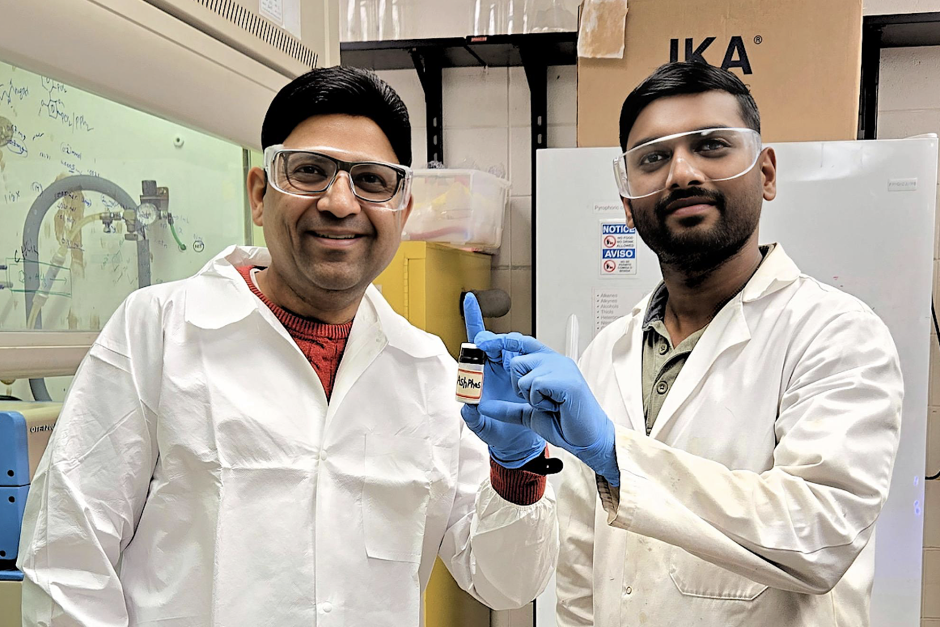By Eric Stann

Jan. 27, 2025
Contact: Eric Stann, 573-882-3346, StannE@missouri.edu
Photo courtesy of Sachin Handa
University of Missouri researchers and collaborators have developed a new chemical tool that could help lower the cost of prescription medications.
The tool, called AshPhos, is a ligand, or molecule, that makes it easier to create special carbon-nitrogen bonds. These bonds are the backbone of more than half of all medicines on the market today.
“What makes AshPhos special from other existing ligands is that it’s made from inexpensive and easy-to-find materials, and it is far better in terms of activity and efficiency,” said Sachin Handa, an associate professor of chemistry at Mizzou’s College of Arts and Science.
That’s by design.
The team, led by Handa and graduate student Ashish Dusunge, alongside Biohaven Pharmaceuticals, developed AshPhos with the goal of promoting sustainable chemistry.
“It’s eco-friendly because it’s made with less waste and uses materials from renewable sources,” Handa said. “It will also make medicine production cheaper, helping more people afford the medications they need.”
Handa, who grew up in India and was a first-generation high school student, knows firsthand the importance of providing affordable life-saving medication.
“Witnessing people in India struggle to access essential health care during my childhood continues to motivate me to use my expertise as a chemist to create solutions that benefit society as a whole,” he said.
Other potential applications
Looking ahead, researchers plan to explore the use of AshPhos beyond pharmaceutical applications.
One idea is to use AshPhos to create nanomaterials that can facilitate hydrogen evolution. Hydrogen is considered a clean energy source, and efficient methods for its production are crucial for transitioning toward renewable energy sources.
Another idea is to investigate how AshPhos could help degrade PFAS, or "forever chemicals.” By developing a catalyst using AshPhos and earth-abundant metals, Handa said they could provide a potential solution for breaking down these persistent pollutants.
While future applications are still under development, they showcase the versatility of AshPhos and highlight its potential to address critical challenges related to energy and environmental sustainability.
The mechanics of AshPhos
How does it work?
“Ligands such as AshPhos facilitate the formation of carbon-nitrogen bonds by stabilizing metal ions and guiding them in reactions, called Buchwald–Hartwig aminations,” said Handa, who was hired through the university’s MizzouForward initiative in 2023. “This is important for highly challenging bulky molecules that otherwise deactivate the catalyst in the absence of AshPhos.”
AshPhos, named in part for Dusunge, the first author of the study, works by binding to a metal atom, transforming it into a catalyst. This catalyst is essential for the reaction to proceed. The metal catalyst then brings together a “highly challenging” molecule containing carbon and another containing nitrogen, facilitating the formation of a carbon-nitrogen bond between them, Handa said.
In the case of AshPhos, the ligand attaches to a metal — palladium — to help it speed up chemical reactions more effectively.
“It acts as a 'boss' by directing the metal what to do, ensuring the metal stays active and selective during the process,” Handa said.
During this process, the ligand might temporarily detach from the metal, rendering it inactive. AshPhos can prevent this from happening by reattaching to the metal with a little heat, ensuring the catalyst remains active and the reaction continues.
“This reattachment ability is key to AshPhos’ effectiveness and makes it superior to many existing ligands,” Handa said. “Our ligand is very strong — it’s like locking a door with a key, ensuring it stays securely closed and won’t open.”
Innovations such as AshPhos are the hallmarks of Mizzou researchers, including Handa, whose work is powering the new Center for Energy Innovation.
“AshPhos ligand: Facilitating challenging aminations in five- and six-membered heteroaryl halides using cyclic secondary and bulky amines,” was published in JACS Au, a journal of the American Chemical Society. The article’s other co-author is David Leahy at Biohaven Pharmaceuticals.
Funding was provided by grants awarded to Handa from the U.S. National Science Foundation (CHE 2044778 and 2345856). AshPhos has received commercial interest from entities in both the U.S. and Europe.
Center for Energy Innovation
Through the Center for Energy Innovation, the University of Missouri is committed to tackling challenges presented through rising energy concerns and rapid growth in artificial intelligence and how the two work together to optimize energy production, transmission and grid security. The facility will bring together engineers, agronomists, physicists, chemists and public policy experts to provide sustainable solutions for the future and strengthen domestic energy supply. Levels of the new center will be dedicated to nuclear energy and nuclear-engineered materials, hydrogen and renewables, energy storage, and grid security, resilience and innovation alongside public policy.



